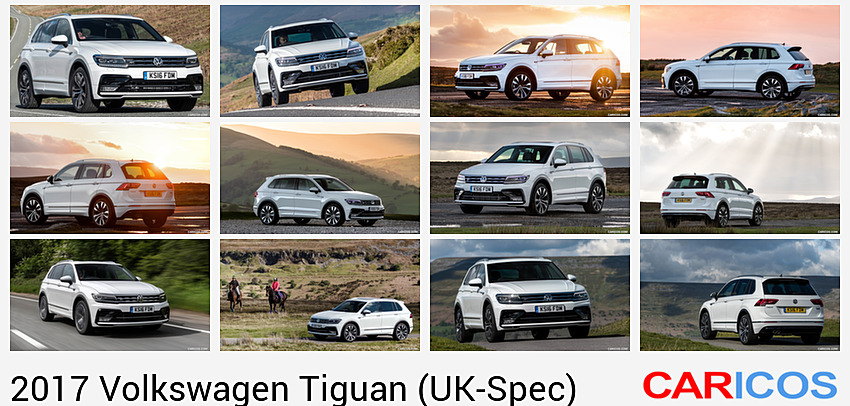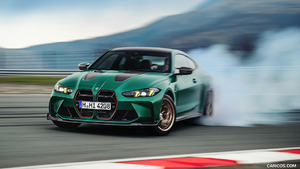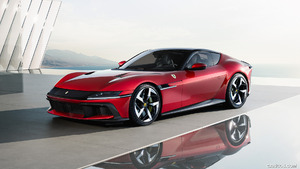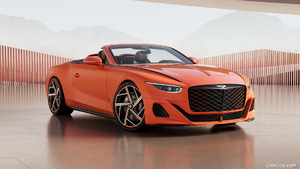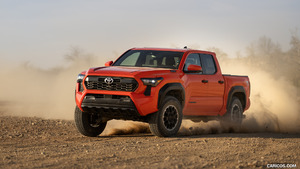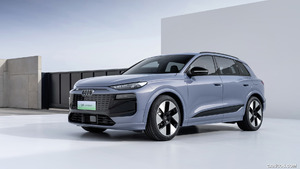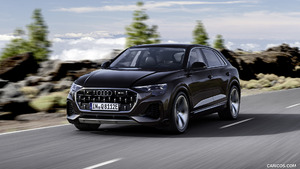Volkswagen Tiguan (UK-Spec)
- New compact SUV sits on hi-tech MQB underpinnings
- Broader range of new engines with more power and better economy
- Designed and engineered to bridge the gap to the premium compact SUV class
The new second generation Volkswagen Tiguan SUV arrives in the UK in June 2016, a full eight years after the debut here of the original car. That first iteration of the Tiguan represented Volkswagen’s entry into the growing compact Sport Utility Vehicle market and the car proved to be a huge success worldwide, selling strongly in the UK and Continental Europe as well as in Russia, the USA, China, Brazil and Australia.
Indeed more than 2.8 million examples of the first generation Tiguan have been sold since launch, with comfortably more than 100,000 of those finding homes in the United Kingdom since the car debuted in February 2008. Tiguan is, in fact, one of the five key pillars of the Volkswagen portfolio in the UK alongside up!, Polo, Golf and Passat. Sales have increased strongly year-on-year in the UK: from 8,121 in 2011 to 21,889 last year. It is now the third best-seller in the UK after Golf and Polo.
Today’s new Tiguan takes the success of the first car and builds on its appeal in every area. Styling, technology, engineering, space, safety, performance and economy: each of these key areas, and many more besides, are comprehensively improved upon in new Tiguan, which leads the charge as Volkswagen readies a comprehensive SUV offensive over the coming years.
The new car becomes the first Volkswagen SUV to sit on the now familiar MQB, or Modularer Querbaukasten (Modular Transverse Matrix) platform, which means it benefits from the latest available technology and shares much of its underpinnings with other successful new models such as the award-winning Golf, Passat and Touran.
 2017 Volkswagen Tiguan (UK-Spec)
2017 Volkswagen Tiguan (UK-Spec)
The car sets new standards for its class in design, comfort and functionality and, in so doing, it also redefines the compact SUV segment. New Tiguan of course remains capable off-road, with a rugged 4MOTION all-wheel drive system that includes premium class technology for use on and off paved surfaces.
Today’s completely redesigned Tiguan benefits from a broad engine selection with the UK launch range set to extend to seven versions of between 115 PS and 240 PS, all of which are more powerful and fuel-efficient than their EU5-compliant predecessors.
With its new 4MOTION Active Control, the Tiguan guarantees crisp acceleration and genuine driving fun in almost every situation and on virtually every type of driving surface. Individual tuning options and driving comfort reach a new level when considered in conjunction with the optionally available dynamic chassis control (DCC) and optional progressive steering system.
A spacious interior paired with a significant gain in boot space – when the rear bench is folded the cargo space, at 1,655 litres, is now 145 litres larger than before – makes for even more practicality in everyday use.
The design of the new Tiguan emphasises style, presence and dynamism. With this car Volkswagen is introducing a completely new design character for its SUVs, which combines striking proportions with a clear commitment to sophistication and authority. This proactive attitude is systematically followed in details such as the horizontally aligned unit formed by the radiator grille and headlights, and the higher waist line compared to the previous model, resulting in a particularly confident stance.
In the UK, the all-new Tiguan is offered in five largely familiar and easily understood trim levels: S, SE, SE Navigation, SEL and R-Line. All models are well equipped, with 17-inch ‘Montana’ alloy wheels standard on even the entry-level Tiguan. Also standard on the S is the Composition Media System, with an eight-inch colour touch-screen. This allows Bluetooth connection and has a built-in DAB digital radio, CD player and 4 x 20 watt output through eight speakers.
Safety is paramount in all Volkswagen passenger cars, and the Tiguan includes driver and front passenger airbags, an airbag curtain system and front seat side impact airbags. Hazard lights flash automatically under hard braking, while Electronic Stability Control, traction control and Trailer Assist are all standard.
Manual air conditioning, electric front and rear windows, rain sensing wipers, auto dimming rear view mirror, cruise control and daytime running lights with Low Beam Assist are among the many standard-fit features on all models in the range, while Lane Assist, Front Assist, dusk sensor and City Emergency Braking enhance the safety of every new Volkswagen Tiguan.
The SE adds 18-inch ‘Patagonia’ wheels, tinted windows from the B-pillar backwards, a leather trimmed three-spoke steering wheel, reading lights, cruise control and parking sensors. It also includes Volkswagen’s Car-Net App-Connect, which allows the ‘mirroring’ of smart phone display on the infotainment touch-screen display as well as myriad other connectivity and app-related functions. Electronic air conditioning is enhanced in a 3Zone package, which means the temperature can be controlled independently for the driver, front passenger and rear seat passengers.
SE Navigation adds satellite navigation, while the SEL has 19-inch ‘Victoria’ alloy wheels, LED headlights with LED daytime running lights and trapezoid exhaust tailpipes. Ambient footwell lighting and a panoramic sunroof add to the styling of the Tiguan. The functionality is lifted everhigher with the addition of the 12.3-inch high-resolution TFT dash display, which has customisable menus and can display the navigation route clearly, just in front of the driver’s viewpoint.
All of these features are included in the Tiguan R-Line, plus striking 20-inch ‘Suzuka’ alloy wheels, sports suspension, a body-coloured spoiler and ‘R-Line’ styling pack. The interior is also upgraded still further to include aluminium-look decorative inserts in the dash and door panels, plus black roof lining and stainless steel pedals.
Three petrol engines and four diesel engines are available. The 1.4-litre TSI opens the petrol range, and provides an output of 125 PS. A second 1.4-litre TSI has cylinder deactivation technology (ACT) and offers up 150 PS. Finally, there’s the spirited 180 PS 2.0-litre TSI.
The entry-level diesel engine is a 2.0-litre TDI unit with 115 PS. There is also a 150 PS 2.0-litre TDI, offered with either a two-wheel drive manual drivetrain or as a 4MOTION four-wheel drive with DSG. A 190 PS 2.0-litre TDI DSG 4MOTION unit is available, and the range is topped by a 2.0-litre BiTDI SCR 4MOTION DSG unit that provides 240 PS. All engines feature BlueMotion Technology. As such they include Stop/Start and battery regeneration systems to enhance fuel economy and reduce emissions.
Naturally the latest Tiguan retains all the versatility and practicality for which the previous model was renowned. This five-door, five-seat SUV even includes an adjustable 40:20:40 split bench rear seat that can slide fore or aft by up to 18 cms, thereby maximising either rear legroom, or boot space.
The first new Tiguans were ordered in the UK in May 2016, with first customer deliveries via the brand’s 227 Volkswagen UK Retailers expected in June.
Summary
- More than 2.8 million Tiguans have been sold since its original global market launch in 2007, with more than 100,000 finding homes in the UK since it went on sale in 2008
- New Tiguan made its world debut at the IAA in Frankfurt in September 2015. It opened for order in the UK in May 2016, priced from £22,510 RRP OTR, with customer deliveries expected to start in June of this year
- New Tiguan kicks off a comprehensive global SUV product offensive which, by the end of this decade, will see Volkswagen offer at least one SUV in each relevant market segment
- There’s a class-leading 2,500 kg towing capacity for all Tiguan versions with 4MOTION all-wheel drive allied to either the MQ500 or DQ500 transmissions
- All seven new engines are EU6 compliant, and all more powerful and more fuel-efficient than the comparable EU5 engines of the previous model. Diesel engines are expected to account for around 90 % of new Tiguan sales
- New design language debuting on the lower, wider and longer new Tiguan creates a distinctive, independent, SUV design character at Volkswagen
- Use of the MQB technology has enabled more striking proportions and a more dynamic design than would have otherwise been possible with line and light concepts, both exterior and interior, supporting the dynamic new look
- Tiguan continues to be built at Volkswagen’s Wolfsburg factory and global headquarters
- Generous interior space of the new Tiguan offers more headroom and up to 29 mm more rear knee room than previously. When the rear bench is folded, the cargo space – at 1,655 litres – is 145 litres larger than before
- Tiguan is the first SUV to sit on the now familiar MQB, or Modularer Querbaukasten (Modular Transverse Matrix) platform – a technology already employed in the award- winning Golf, Passat and Touran model ranges
- In the UK, the all-new Tiguan is offered in five largely familiar and easily understood trim levels: S, SE, SE Navigation, SEL and R-Line. All models are very well equipped with, for instance, 17-inch ‘Montana’ alloy wheels standard on even the entry-level Tiguan
- Best-selling model in the UK is likely to be the 2.0 TDI 150PS manual with 4MOTION, in SE Navigation trim. Tiguan sales generally are expected to be split roughly 50:50 between fleet and retail buyers
- 4MOTION Active Control delivers safety at the push of a button while Adaptive chassis control (DCC) offers individual and improved driving properties, and progressive steering ensures maximum precision
- New Tiguan sets standards in its class when it comes to safety offering such hi-tech features as Front Assist with City Emergency Braking and Pedestrian Monitoring; automatic post-collision braking and Lane Assist
- Tiguan is the first Volkswagen model to be offered with an active bonnet which reduces the risk of injury to pedestrians and cyclists by lifting upward by 50 mm in the event of an impact
Market Information
The Tiguan competes in the compact SUV (or A-SUV) class, and is a rival to such vehicles as the Toyota RAV4, Nissan Qashqai, Honda HR-V, Ford Kuga and Mazda CX-3. Taken together, it is anticipated that the AO, A, B, C and D SUV segments will make up 28% of the UK car market by 2018.
Production
Situated on the banks of Mittellandkanal, an inland artificial waterway, Volkswagen’s Wolfsburg plant is the world’s largest single car-manufacturing complex and covers an area of more than six square kilometres – that’s an area large enough to accommodate the entire Principality of Monaco. The network of roads connecting the individual production facilities, warehouses, administration buildings and outdoor facilities covers a distance of 75 kilometres, with 70 kilometres of railway tracks accommodating seven locomotives, two shunting robots and a traverse.
The Tiguan is built here, along with the Golf, Golf SV, e-Golf, Golf GTE and Golf GTI, and Touran. In addition to these whole models, the site also makes components – an important mainstay of the plant portfolio – such as cardan drive shafts and injection-moulded parts, which are either used in production at the plant itself or supplied to other Group production sites. Around 815,000 vehicles were built at Wolfsburg in 2015 and some 74,000 people were employed there.
The two power stations operated in Wolfsburg by Volkswagen Kraftwerk GmbH generate supplies not only for the Volkswagen plant, but they also supply power and district heating to the City of Wolfsburg. Both power stations have an installed electricity capacity of 442 megawatts at their disposal.
With its “Think Blue. Factory.” initiative, the Volkswagen brand has set itself clear targets for the environmentally sustainable positioning of all its plants. By 2018, the aim is to reduce the environmental impact of production at all Volkswagen plants by 25 percent. Specifically, this means 25 percent lower energy and water consumption, waste volumes and emissions at all plants.
One contribution to sustained energy saving is the Energy Path. The Wolfsburg Energy Path initiative features a large number of practical examples showing precisely where and how energy can be saved. These include an electric vehicle recharging station with photovoltaic panels and wind turbine and the optimization of heating pumps featuring demand-oriented control to save energy. In July 2013, the plant commissioned the first hybrid locomotives. Currently, three of these locomotives, which reduce noise levels by 90% and fuel consumption by 50%, are in service.
History
The history of the Wolfsburg plant is closely linked to the history of the City of Wolfsburg, since both were founded in the same year. Close co-operation continues to exist between Volkswagen Aktiengesellschaft and the city. A mutual enterprise, Wolfsburg AG, was founded in 1999 as a product of this close attachment. A public-private partnership, the initiative was launched as a means of realising the AutoVision aim to strengthen Wolfsburg’s economic standing for the long term. By providing support for company start-ups and incentives for established companies to set up business in Wolfsburg, by creating concepts for and establishing recreational attractions and health projects and by providing human-resource services, the Wolfsburg AG initiative has helped to create and secure more than 11,000 jobs to date.
AutoVision GmbH was founded in 2001 as a platform on which to implement the AutoVision concept. A 100 percent subsidiary of Volkswagen, the mission of AutoVision GmbH is to help give the Group even more competitive edge. Its activities are concentrated in the fields of ‘administration and technical services’ and ‘human-resource services’. The company also offers this portfolio of services on the external market.
Additional areas of operation dedicated exclusively to the Volkswagen Group include venture-capital undertakings and the provision of development support for process innovations.
The world-famous Autostadt is also a key feature of the Wolfsburg skyline. As a communication platform of the Volkswagen Group, the Autostadt in Wolfsburg presents the values of the Group and the topic of mobility in all its facets under the motto of “People, cars and what moves them”. Since it was opened in 2000, more than 33 million guests have visited this theme park and educational centre. The Autostadt is also the world’s largest car delivery centre and includes ZeitHaus, the world’s best-visited automobile museum. With a wide variety of cultural events such as the annual Movimentos festival weeks, the Autostadt is an international meeting point for people interested in culture. In 2015, the Autostadt reported record results, with 2.42 million visitors and 168,514 new vehicles delivered to customers.
The MQB Platform
The new Tiguan uses as its base the Volkswagen Group’s MQB (Modularer Querbaukasten) platform or Modular Transverse Matrix. The introduction of the MQB strategy represents a turning point in the design and production of future automobiles with transversemounted engines as it standardises many vehicle component parameters – across brands and vehicle classes – and at the same time, it offers access to new technologies.
The MQB extends from the A0 to the B segment. At the Volkswagen brand, for example, it covers the following models: Polo, Beetle, Golf, Scirocco, Jetta, Touran, Sharan, Passat and Volkswagen CC. In the future, all of these models could theoretically be produced on the same assembly line – despite their different wheelbases and track widths. It will also be possible to produce MQB models of different brands together.
One of the prominent characteristics of the Modular Transverse Matrix is the uniform mounting position of all engines. Two systems integrated in the MQB strategy which play a key role here are the modular petrol (MOB) and diesel (MDB) engine systems.
By introducing these new engine series, the number of engine and gearbox variants offered by the Group will be reduced by around 90 per cent, without restricting choice. In addition to standardising conventional internal combustion engines, the MQB also enables an identical mounting position for all current alternative drive concepts without limitations – from natural gas and hybrid versions to pure electric drive.
Exterior Design
The unmistakable SUV profile of the new Tiguan radiates authority, confidence and control. This impression is created because the designers, under the leadership of Klaus Bischoff, applied a simple ethos: less is more.
The proportions of the base model with front-wheel drive give it a powerful stance on the road with a 33 mm reduction in height to 1,632 mm and a 30 mm increase in width to 1,839 mm. At 4,486 mm in length, it is also 60 mm longer than its predecessor. The wheelbase has been extended to 2,681 mm – an increase of 77 mm.
At the front, in particular, the unit formed by the radiator grille and the optional LED projection headlights reinforces the car’s powerful impression and upright stance. At the sides, the waist and character lines as well as the eye-catching wheel arches attest to the creativity of the designers.
The well thought-out production technology is similarly worthy of note. For instance, the door handles have been integrated seamlessly. Meanwhile the Tiguan’s character line helps to define a rear section whose clear edges and horizontally aligned surfaces expertly continue the story of sporty all-rounders.
When it comes to aerodynamics, the new Tiguan has been significantly optimised. It has a Cd figure as low as 0.32 and is therefore 13 per cent better than its predecessor’s 0.37. This has been achieved via a number of small and seemingly insignificant individual measures – from the aerodynamically efficient car body to an optimised underbody concept.
Compared with models that have EU5 engines, the weight of the new Tiguan has been reduced by up to 53 kg. In the body alone, around 12 kg of weight is saved despite the longer wheelbase and longer vehicle length.
Lightweight design measures were implemented such as “tailored blanks” – the load-optimised thickening of sheet metal blanks. In addition, optimising the rear portal and the cross members between the rear wheel housings have made the body much stiffer, despite a significant lengthening of 77 mm in the critical zone between the A and C pillars.
The rear hatch has also been enlarged compared with the previous model. Nonetheless, the important parameter of torsional rigidity is optimised in the new Tiguan. At 28,000 Nm/degree without a panoramic roof, and 25,000 Nm/degree with the panoramic roof, the figures for the new Tiguan comfortably surpass those of the previous model.
Interior Design
The new Tiguan’s interior designers determined that size is not an end in itself. But it is one of the factors that determine comfort and, as such, the new Tiguan – with an interior 26 mm longer than previously – is now one of the most spacious cars in its class. At the rear, up to three passengers can now enjoy 29 mm more knee room. Despite its lower overall height, the vehicle has a clever ergonomic design that actually offers more headroom than before. And seat height, which customers consider so very important in an SUV of any class, has been raised 8 mm in the new Tiguan.
The car also offers a sliding rear bench that has been optimised to permit 180 mm of adjustment – 20 mm more than in the previous model. When the rear bench is slid forwards, the boot offers 615 litres of space, which is a gain of some 145 litres. When the rear bench is folded, the vehicle’s 1,655 litres of boot volume is enough for all manner of large loads.
The SUV design language of the exterior is seamlessly carried through the interior. The dashboard is now aligned towards the driver for better comfort and without constricting or disturbing the airy impression of the interior. At the same time, the wider centre console typical of SUVs is paired with the new 4MOTION Active Control rotary switch to create a defining interior element with a premium feel as in the current Touareg. In the pleasant atmosphere of the ambient lighting the sophisticated overall impression is completed by the panoramic roof (870 mm x 1,364 mm, available as an option) and details like the elegant door handles and smart trim strips.
Technology
By virtue of its MQB underpinnings, the new Tiguan is packed with the very latest technology. For instance, new to the compact SUV class is the Active Info Display – familiar from the latest Passat – and now with SUV-specific instruments.
Active Info Display
In combination with the display of the radio or navigation system this creates a virtual, flexible human-machine interface (HMI) whose displays complement one another.
Six different views are available for the 12.3-inch Active Info Display. Unique to the Tiguan is an off-road display profile with steering angle indicator and compass that was specially designed for the car. When navigation is activated the large central display can be selected, as in the Passat. Here, 3D navigation is shown directly in the Active Info Display, in addition to the infotainment screen (see image on p19).
Head-up Display
Navigating is also supported by the optional retractable head-up display – optional on SE and above – that is integrated into the Tiguan’s dashboard and boasts laseretched texturing. Using technology originally developed for fighter pilots relevant driver information such as driving speed, current speed limit, direction arrows for navigation and indicators for the driver assistance systems are projected directly onto the display and thereby into the driver’s line of sight.
Area view with Park Assist
Optionally available across the range the system features four separate cameras, located in the rear tailgate, door mirrors and radiator grille, that provide a 360-degree view around the new Tiguan, helping the driver to manoeuvre with confidence in any direction. The driver can select up to 12 possible views of the vehicle, from the front, rear or side, on either full or split-screen displayed on the infotainment system. Should the optional Discover Navigation Pro system be specified, the driver will also gain a bird’s-eye view around the new Tiguan.
Trailer Assist
The new Tiguan effortlessly tows a trailer or caravan and, depending on the choice of engine, can tow up to a maximum weight of 2.5 tons. Trailer Assist including Park Assist and rear-view camera helps the driver reverse more easily and accurately with a trailer or caravan attached. The optical display visualises actual and possible steering angles in the instrument cluster. Reverse steering is automatic, with direction controlled via the mirror adjustment switch which acts as a joystick, while the driver controls the pedals and keeps a good look out. The feature, optional on SE models and above, is available in conjunction with the optional swivelling towbar.
Infotainment
MIB-based infotainment
In the new Tiguan Volkswagen is implementing the latest generation of infotainment systems, based on the brand’s Modular Infotainment Platform (MIB).
Kicking off the line-up, the entry level Composition Media system comes with an eight-inch colour touchscreen. Further up the scale, the Discover Media and optional Discover Pro navigation units feature larger eight-inch displays and come with the Guide & Inform online services as standard.
To activate these services, all the user needs to do is register with Car-Net using a SIM card via the CarStick, or wi-fi hot spot of a smartphone or business phone. All services can be used free-of-charge for the first year.
Delivering a truly exceptional sound experience in the new Tiguan is the optional 400-watt DYNAUDIO Excite Surround system with a digital 10-channel amplifier, subwoofer and centre speaker integrated in the cockpit. The low-resonance loudspeakers were meticulously tuned to the new Tiguan for perfect surround sound.
Media Control and App-Connect
The optional package of Media Control and App-Connect provide a connection to all manner of portable consumer electronic devices in the new Tiguan. Examples of the system’s many different capabilities include Media Control which can be used by the front seat passenger, or even by a passenger on the rear bench, to conveniently input a navigation route from a tablet computer to the infotainment system, or to update the play list.
And with App-Connect, nearly any current smartphone can be fully integrated in the new Tiguan via Apple CarPlay, Android Auto or MirrorLink. The risk of distraction while driving is also reduced by use of the USB port on the centre console to mirror the smartphone display onto the vehicle’s display. The driver can even use the MirrorLink app Cam Connect to have images shown on the display of the radio or navigation system sourced from a GoPro camera mounted in, for instance, a horse box being towed by the new Tiguan.
Using ‘Google Street View’, it is possible to integrate 360-degree panoramic images from the street-level perspective on the display screen and use the Google Earth™ map service to call up a realistic photographic image of the map representation (Google Maps).
Further functions available to Discover Pro users are ‘Parking place information’ (number of available parking spaces in parking structures, including location), ‘Petrol station prices’ (current fuel prices, including location), ‘Weather’, ‘News’ and ‘Vehicle status report’ (e.g. maintenance related information). The convenience package for online and media functions is rounded off with an inductive charging tray for certain smartphones.
Safety
The new Tiguan’s MQB platform has allowed Volkswagen to integrate even more active and passive safety systems and features. Standard features in the UK include Front Assist with Pedestrian Monitoring, active engine bonnet and Lane Assist. The safety equipment is completed by a network of seven airbags – including a knee airbag on the driver’s side. It sets standards, and not only for A-SUVs.
The new Tiguan, like all Volkswagen cars based on the MQB platform, also comes with the automatic post-collision braking system which helps to avoid dangerous secondary collisions. Front Assist
Front Assist, which is included as standard across the range, monitors the surroundings by radar sensor and brakes via an emergency braking function if the driver has overlooked an obstacle. For the first time in this model, this type of sensing in the new Tiguan is exclusively by radar sensor and not in combination with the multifunction camera. It initiates a two-stage reaction if a pedestrian is detected on the road. First a warning is given, then the system activates the braking function. The Lane Assist lane departure warning system that is included as standard and also arrives as a new feature in the compact SUV segment.
Driver Alert and Emergency Assist
Other examples of standard safety solutions include the Driver Alert System and adaptive cruise control (ACC). When specified with a DSG gearbox, the ACC becomes a traffic jam assistant that assumes the majority of driving work in stopand-go traffic. Another component of the driver assistant package is Emergency Assist. In an emergency, this extension of Lane Assist initiates a full emergency stop, performed only after an extended warning by Lane Assist that involves activating the hazard warning lights and driving in a controlled swaying pattern within the driving lane to alert other drivers.
Side Scan
Providing assistance if the driver wants to change lanes from speeds of 37 mph upwards the system uses sensors in the rear of the vehicle to monitor the traffic. Should they detect any road users in a blind spot or vehicles approaching quickly from behind, it alerts the driver via a warning light within the door mirror housing and an audible warning in the vehicle. Meanwhile the parking assistant monitors the area behind and next to the car, alerting the driver if it detects a vehicle or object, and automatically instigating an emergency stop if a collision is imminent. In the UK, these features are optional on SE models and above.
Active bonnet
The active bonnet – a first for any Volkswagen - reduces the risk of injury to pedestrians and cyclists. When contact is made with the bumper, a sensor strip triggers a pyrotechnic actuator that lifts the rear edge of the bonnet by around 50 mm within 22 milliseconds. This increases the distance between the hard engine components and the relatively flexible bonnet. In turn, it reduces the risk of serious head injuries.
COMFORT
As sporty and rugged as the new Tiguan appears, it is still uncompromising when it comes to comfort. The new model has made significant gains compared with the already comfortable previous model, from the larger interior – in which high-quality materials form a harmonious unit together with the completely redesigned cockpit – to the flexible and capacious boot space.
Seat structures
The second generation seat structure being used for the first time in the new Tiguan delivers relaxed comfort – even on rough surfaces. The front seat structure, whose weight has been reduced substantially, is being used for the first time at Volkswagen in the new Tiguan. Weight savings of 20 per cent have been achieved by the new design approaches that utilise innovative materials and production methods. In addition, the wires that are woven in a complex pattern in the seat surface help to achieve light springing – and thereby an improvement in comfort, especially on uneven driving surfaces.
The driver and front passenger sit much more comfortably overall, courtesy of this standard feature. The ergoActive seats used from the SE equipment level, are equipped with 14-way seat adjustment, massage function (driver’s side) and optional seat heating. Their comfort has been significantly improved over longer periods of driving in the new Tiguan, and the foam contours of the seats have been completely redesigned compared to the previous model. The contours offer better lateral support for passengers and the foam offers a much more flexible fit to the body.
Automatic climate control: 3Zone innovation
The new 3Zone climate control system in today’s Tiguan naturally offers truly personalised climate comfort for driver and passengers. The air quality sensor with allergen filter prevents hazardous materials from entering the car’s interior, while sun and humidity sensors help to achieve optimal climate control in the interior and regulate air humidity, thereby reducing the incidence of window fogging.
Engines, Transmissions and Runninggear.
The extended engine range of the new Tiguan delivers a broader choice than ever before, with the emphasis spread neatly between power and economy. Refinement, of course, applies across the board. The three petrol engines available to customers in the UK offer power outputs from 125 PS to 180 PS, and the diesel engines from 115 PS to 240 PS. All are more powerful and more fuel-efficient than the comparable EU5 engines of the previous model.
When order books first opened here in May 2016, the initial wave of engine offerings saw the high-volume diesel made available as a 2.0 TDI with 150 PS, mated to either a dual clutch gearbox (DSG) with 4MOTION all-wheel drive or allied to a six-speed manual transmission and front-wheel drive. In addition, the 2.0 TSI with 180 PS, 4MOTION and DSG is a completely new engine that has also been available to order since May.
Volkswagen extended its range of all-wheel drive models with two more 2.0 TDI engines (190 PS and 240 PS) and two additional TSI engines (a 1.4 125 PS and a 1.4 150 PS with Active Cylinder Technology - ACT). Volkswagen is the first carmaker to implement this fuel saving cylinder deactivation technology on four-cylinder engines, as it was previously the preserve of large eight- or 12-cylinder engines. Shutting down the second and third cylinders during low and medium load states reduces fuel consumption in the EU driving cycle.
Starting with engines that have a power of 180 PS, an automatically shifting DSG is included as standard. DSG is available as an option for the 150 PS versions. A look at the top engine reveals one of the highest specific power figures in the A-SUV segment: the 240 PS engine (2.0 TDI) familiar from the Passat with twin turbocharging and 2,500 bar of fuel injection pressure transfers 119 PS of power per litre displacement to the road.
As of June 2016, the line-up of engines available for order in new Tiguan – subject to model choice – is:
DIESEL ENGINES
- 2.0 litre TDI 115 PS common rail diesel engine with up to 320 Nm of torque: EU6 emissions standard, four cylinder in-line common rail diesel engine, with four valves per cylinder. Fitted with a turbocharger and a DPF (diesel particulate filter) with SCR (Selective Catalytic Reduction). Available with a six speed manual transmission.
- 2.0 litre TDI 150 PS common rail diesel engine with up to 340 Nm of torque: EU6 emissions standard, four cylinder in-line common rail diesel engine, with four valves per cylinder. Fitted with a turbocharger and a DPF (diesel particulate filter) with SCR (Selective Catalytic Reduction). Available with a six speed manual or a seven speed automatic DSG transmission.
- 2.0 litre TDI 190 PS common rail diesel engine with up to 400 Nm of torque: EU6 emissions standard, four cylinder in-line common rail diesel engine, with four valves per cylinder. Fitted with a turbocharger and a DPF (diesel particulate filter) with SCR (Selective Catalytic Reduction). Available with a seven speed automatic DSG transmission.
- 2.0 litre TDI 240 PS common rail diesel engine with up to 500 Nm of torque: EU6 emissions standard, four cylinder in-line common rail diesel engine, with four valves per cylinder. Fitted with a turbocharger and a DPF (diesel particulate filter) with SCR (Selective Catalytic Reduction). Available with a seven speed automatic DSG transmission.
PETROL ENGINES
- 1.4-litre TSI 125 PS petrol engine with up to 200 Nm of torque: EU6 emissions standard, four cylinder in-line direct injection turbocharged engine, with four valves per cylinder. Available with a six speed manual transmission.
- 1.4-litre TSI 150 PS petrol engine with up to 250 Nm of torque: EU6 emissions standard, four cylinder in-line direct injection turbocharged engine, with four valves per cylinder. ACT Active Cylinder Technology. Available with a six speed manual transmission.
- 2.0 litre TSI 180 PS petrol engine with up to 320 Nm of torque: EU6 emissions standard, four cylinder in-line direct injection turbocharged engine, with four valves per cylinder. Available with a six speed manual or a seven speed automatic DSG transmission.
Drive
All-wheel drive is a key feature for many Tiguan buyers. In the UK, 75 percent of buyers of the previous version opted for allwheel drive. In new Tiguan, it once again comes in the form of the highly efficient 4MOTION all-wheel drive system either as an option or as standard, depending on the engine selected. Offering great grip on the roughest roads and in the worst weather, 4MOTION constantly monitors driving conditions and reacts to the slightest wheel slip, delivering extra traction to the wheels with the most grip. All this happens in milliseconds, through control units linked to the car’s dynamic sensors, engine management system and gearbox. At the heart of the system is an inter-axle differential – a fifth generation Haldex coupling – which shares power between the front and rear axle, sending it where it’s most needed. At the same time, the smaller differences in rotational speed when cornering or manoeuvring have to be balanced to stop torsional stresses in the drive train. The differential is designed to work with the car’s other active safety systems such as the anti-lock braking system (ABS) and the electronic stability programme (ESP).
The ground clearance of all Tiguan 4MOTION versions is 11 mm higher (200 mm instead of 189 mm). In addition, the Tiguan can be ordered with an ‘Outdoor’ pack with a special off-road front end that provides an approach angle of 25.6 degrees instead of the usual 18.3 degrees. The departure angle at the rear is 24.7 degrees for all versions, while the ramp angle is 20 degrees. Regardless of whether the vehicle has an on-road or off-road front end design, the new Tiguan is engineered for very large trailer loads of up to 2,500 kgs – depending on engine/gearbox choice.
New on this generation of Tiguan is the high-spec 4MOTION Active Control. The intuitively operated rotary/push-button switch is located on the centre console and allows the driver to activate one of four driving modes. When the driver turns the switch to the left one of the two road profiles: ‘Onroad’ or ‘Snow’ is activated. When the switch is turned to the right, the driver selects one of the two off-road profiles: ‘Offroad’ (automatic setting of off-road parameters) or ‘Offroad Individual’ (variable settings). When driving off-road, 4MOTION Active Control lets drivers switch the assistance systems in seconds with a single manual operation.
Off-road, the new Tiguan is nothing short of a confident trailblazer. The electronic accelerator pedal can be metered precisely and if the 4MOTION is equipped with DSG, the dual clutch gearbox upshifts later. The driver can avoid mandatory shifts by changing gears via the tip gate (+/-); this also facilitates engine braking. In this case “automatic freewheeling” is deactivated, which is decoupling of the engine to make use of the kinetic energy of coasting. Traction control (ASR) governs engine speed and simultaneously manages traction and driving stability. In parallel, the steering system and adaptive damper control switch over to a suitable driving profile. Electronic Stability Control (ESC) activates the Offroad characteristic, and the driver assistance systems for hill ascent and descent come into play. In addition, the dynamic cornering lights open up a brighter and wider light pattern near the car.
The driving experience is further optimised by the optionally available adaptive chassis control (DCC). The Tiguan has been tuned with new control valves for greater ride comfort and a broader spread of driving profiles. The chassis control system delivers a breadth of choices to suit different driving styles – very conveniently at the push of a button. Meanwhile, the optional progressive steering system assures precise and dynamic driving.
Servicing and Warranty
Servicing
Volkswagen offers customers a choice of servicing regime for their Tiguan. They can choose Fixed Service or Flexible Service and the appropriate selection is entirely dependent on how the car is likely to be driven and its general use.
The Fixed Service regime is recommended for vehicles that will cover less than 10,000 miles in 12 months and if the vehicle is likely to be used in the following way:
- Predominantly urban driving, short journeys with frequent cold starts
- Activities regularly producing high engine loading, for example frequent hill climbs, driving with vehicle fully loaded and towing
- Driving with high rpm, hard acceleration and heavy braking In this case, the vehicle will be serviced at regular intervals, at every 10,000 miles or every 12 months.
Flexible Service is recommended for vehicles with a daily mileage of more than 25 miles, where the vehicle is driven regularly and on mainly longer distance journeys. The vehicle should be mainly driven at a constant speed with minimum vehicle and engine loading, minimal towing and driven in an economical manner.
In this case, the on-board computer informs the driver via a dashboard display, when the vehicle needs a service. A range of engine sensors electronically monitors the vehicle’s oil temperature, oil pressure, oil level and brake pad wear to establish when a service is needed.
With the Flexible regime, the vehicle can cover typically between 10,000 and 18,000 miles (approx) or 24 months (whichever is sooner) between oil changes. An inspection service is typically due in the third year of ownership or at 40,000 miles and thereafter every second year for vehicles with an annual mileage of around 10,000 miles.
Customers can choose between Fixed and Flexible at PDI (pre-delivery inspection) and though it is possible to change from one to another during the vehicle’s lifetime it can only be done when a full inspection service is due.
Warranty
The Tiguan has a three-year (first- and second-year manufacturer operated, third-year retailer-operated) / 60,000-mile mechanical warranty. In addition, it comes with a 12-year body protection guarantee, three year paint warranty and a year’s membership of Volkswagen Assistance which includes European breakdown cover. The latter can be extended at minimal cost to the customer.

